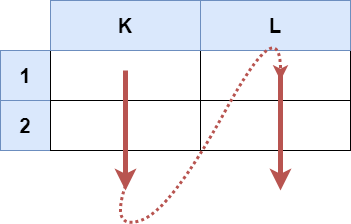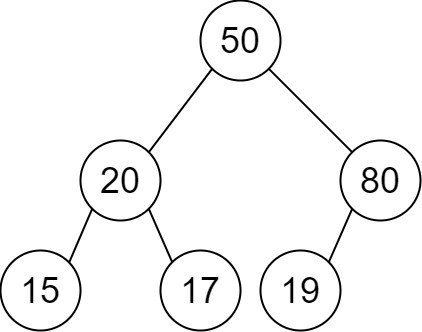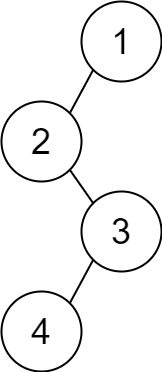weekly-contest-283
A
Statement
Metadata
- Link: Excel 表中某个范围内的单元格
- Difficulty: Easy
- Tag:
Excel 表中的一个单元格 (r, c) 会以字符串 "<col><row>" 的形式进行表示,其中:
<col>即单元格的列号c。用英文字母表中的 字母 标识。- 例如,第
1列用'A'表示,第2列用'B'表示,第3列用'C'表示,以此类推。
- 例如,第
<row>即单元格的行号r。第r行就用 整数r标识。
给你一个格式为 "<col1><row1>:<col2><row2>" 的字符串 s ,其中 <col1> 表示 c1 列,<row1> 表示 r1 行,<col2> 表示 c2 列,<row2> 表示 r2 行,并满足 r1 <= r2 且 c1 <= c2 。
找出所有满足 r1 <= x <= r2 且 c1 <= y <= c2 的单元格,并以列表形式返回。单元格应该按前面描述的格式用 字符串 表示,并以 非递减 顺序排列(先按列排,再按行排)。
示例 1:

输入:s = "K1:L2"
输出:["K1","K2","L1","L2"]
解释:
上图显示了列表中应该出现的单元格。
红色箭头指示单元格的出现顺序。
示例 2:

输入:s = "A1:F1"
输出:["A1","B1","C1","D1","E1","F1"]
解释:
上图显示了列表中应该出现的单元格。
红色箭头指示单元格的出现顺序。
提示:
s.length == 5'A' <= s[0] <= s[3] <= 'Z''1' <= s[1] <= s[4] <= '9's由大写英文字母、数字、和':'组成
Metadata
- Link: Cells in a Range on an Excel Sheet
- Difficulty: Easy
- Tag:
A cell (r, c) of an excel sheet is represented as a string "<col><row>" where:
<col>denotes the column numbercof the cell. It is represented by alphabetical letters.- For example, the
1stcolumn is denoted by'A', the2ndby'B', the3rdby'C', and so on.
- For example, the
<row>is the row numberrof the cell. Therthrow is represented by the integerr.
You are given a string s in the format "<col1><row1>:<col2><row2>", where <col1> represents the column c1, <row1> represents the row r1, <col2> represents the column c2, and <row2> represents the row r2, such that r1 <= r2 and c1 <= c2.
Return the list of cells (x, y) such that r1 <= x <= r2 and c1 <= y <= c2. The cells should be represented as strings in the format mentioned above and be sorted in non-decreasing order first by columns and then by rows.
Example 1:

Input: s = "K1:L2"
Output: ["K1","K2","L1","L2"]
Explanation:
The above diagram shows the cells which should be present in the list.
The red arrows denote the order in which the cells should be presented.
Example 2:

Input: s = "A1:F1"
Output: ["A1","B1","C1","D1","E1","F1"]
Explanation:
The above diagram shows the cells which should be present in the list.
The red arrow denotes the order in which the cells should be presented.
Constraints:
s.length == 5'A' <= s[0] <= s[3] <= 'Z''1' <= s[1] <= s[4] <= '9'sconsists of uppercase English letters, digits and':'.
Solution
#include <bits/stdc++.h>
#include <ext/pb_ds/assoc_container.hpp>
#include <ext/pb_ds/tree_policy.hpp>
#define endl "\n"
#define fi first
#define se second
#define all(x) begin(x), end(x)
#define rall rbegin(a), rend(a)
#define bitcnt(x) (__builtin_popcountll(x))
#define complete_unique(a) a.erase(unique(begin(a), end(a)), end(a))
#define mst(x, a) memset(x, a, sizeof(x))
#define MP make_pair
using ll = long long;
using ull = unsigned long long;
using db = double;
using ld = long double;
using VLL = std::vector<ll>;
using VI = std::vector<int>;
using PII = std::pair<int, int>;
using PLL = std::pair<ll, ll>;
using namespace __gnu_pbds;
using namespace std;
template <typename T>
using ordered_set = tree<T, null_type, less<T>, rb_tree_tag, tree_order_statistics_node_update>;
const ll mod = 1e9 + 7;
template <typename T, typename S>
inline bool chmax(T &a, const S &b) {
return a < b ? a = b, 1 : 0;
}
template <typename T, typename S>
inline bool chmin(T &a, const S &b) {
return a > b ? a = b, 1 : 0;
}
#ifdef LOCAL
#include <debug.hpp>
#else
#define dbg(...)
#endif
// head
class Solution {
public:
vector<string> cellsInRange(string s) {
int col1 = s[0];
int row1 = s[1];
int col2 = s[3];
int row2 = s[4];
vector<string> res;
for (int i = col1; i <= col2; i++) {
for (int j = row1; j <= row2; j++) {
res.push_back(std::string(1, char(i)) + std::string(1, char(j)));
}
}
return res;
}
};
#ifdef LOCAL
int main() {
return 0;
}
#endif
B
Statement
Metadata
- Link: 向数组中追加 K 个整数
- Difficulty: Medium
- Tag:
给你一个整数数组 nums 和一个整数 k 。请你向 nums 中追加 k 个 未 出现在 nums 中的、互不相同 的 正 整数,并使结果数组的元素和 最小 。
返回追加到 nums 中的 k 个整数之和。
示例 1:
输入:nums = [1,4,25,10,25], k = 2
输出:5
解释:在该解法中,向数组中追加的两个互不相同且未出现的正整数是 2 和 3 。
nums 最终元素和为 1 + 4 + 25 + 10 + 25 + 2 + 3 = 70 ,这是所有情况中的最小值。
所以追加到数组中的两个整数之和是 2 + 3 = 5 ,所以返回 5 。示例 2:
输入:nums = [5,6], k = 6
输出:25
解释:在该解法中,向数组中追加的两个互不相同且未出现的正整数是 1 、2 、3 、4 、7 和 8 。
nums 最终元素和为 5 + 6 + 1 + 2 + 3 + 4 + 7 + 8 = 36 ,这是所有情况中的最小值。
所以追加到数组中的两个整数之和是 1 + 2 + 3 + 4 + 7 + 8 = 25 ,所以返回 25 。
提示:
1 <= nums.length <= 1051 <= nums[i], k <= 109
Metadata
- Link: Append K Integers With Minimal Sum
- Difficulty: Medium
- Tag:
You are given an integer array nums and an integer k. Append k unique positive integers that do not appear in nums to nums such that the resulting total sum is minimum.
Return the sum of the k integers appended to nums.
Example 1:
Input: nums = [1,4,25,10,25], k = 2
Output: 5
Explanation: The two unique positive integers that do not appear in nums which we append are 2 and 3.
The resulting sum of nums is 1 + 4 + 25 + 10 + 25 + 2 + 3 = 70, which is the minimum.
The sum of the two integers appended is 2 + 3 = 5, so we return 5.Example 2:
Input: nums = [5,6], k = 6
Output: 25
Explanation: The six unique positive integers that do not appear in nums which we append are 1, 2, 3, 4, 7, and 8.
The resulting sum of nums is 5 + 6 + 1 + 2 + 3 + 4 + 7 + 8 = 36, which is the minimum.
The sum of the six integers appended is 1 + 2 + 3 + 4 + 7 + 8 = 25, so we return 25.
Constraints:
1 <= nums.length <= 1051 <= nums[i], k <= 109
Solution
#include <bits/stdc++.h>
#include <ext/pb_ds/assoc_container.hpp>
#include <ext/pb_ds/tree_policy.hpp>
#define endl "\n"
#define fi first
#define se second
#define all(x) begin(x), end(x)
#define rall rbegin(a), rend(a)
#define bitcnt(x) (__builtin_popcountll(x))
#define complete_unique(a) a.erase(unique(begin(a), end(a)), end(a))
#define mst(x, a) memset(x, a, sizeof(x))
#define MP make_pair
using ll = long long;
using ull = unsigned long long;
using db = double;
using ld = long double;
using VLL = std::vector<ll>;
using VI = std::vector<int>;
using PII = std::pair<int, int>;
using PLL = std::pair<ll, ll>;
using namespace __gnu_pbds;
using namespace std;
template <typename T>
using ordered_set = tree<T, null_type, less<T>, rb_tree_tag, tree_order_statistics_node_update>;
const ll mod = 1e9 + 7;
template <typename T, typename S>
inline bool chmax(T &a, const S &b) {
return a < b ? a = b, 1 : 0;
}
template <typename T, typename S>
inline bool chmin(T &a, const S &b) {
return a > b ? a = b, 1 : 0;
}
#ifdef LOCAL
#include <debug.hpp>
#else
#define dbg(...)
#endif
// head
class Solution {
public:
long long minimalKSum(vector<int> &nums, int k) {
nums.push_back(0);
nums.push_back(2e9);
sort(nums.begin(), nums.end());
long long res = 0;
auto f = [](int l, int r, int &remind) -> long long {
int _r = l + remind - 1;
r = min(r, _r);
if (l > r) {
return 0;
}
remind -= r - l + 1;
return 1ll * (l + r) * (r - l + 1) / 2;
};
int n = nums.size();
for (int i = 0; i < n - 1; i++) {
res += f(nums[i] + 1, nums[i + 1] - 1, k);
}
return res;
}
};
#ifdef LOCAL
int main() {
return 0;
}
#endif
C
Statement
Metadata
- Link: 根据描述创建二叉树
- Difficulty: Medium
- Tag:
给你一个二维整数数组 descriptions ,其中 descriptions[i] = [parenti, childi, isLefti] 表示 parenti 是 childi 在 二叉树 中的 父节点,二叉树中各节点的值 互不相同 。此外:
- 如果
isLefti == 1,那么childi就是parenti的左子节点。 - 如果
isLefti == 0,那么childi就是parenti的右子节点。
请你根据 descriptions 的描述来构造二叉树并返回其 根节点 。
测试用例会保证可以构造出 有效 的二叉树。
示例 1:

输入:descriptions = [[20,15,1],[20,17,0],[50,20,1],[50,80,0],[80,19,1]]
输出:[50,20,80,15,17,19]
解释:根节点是值为 50 的节点,因为它没有父节点。
结果二叉树如上图所示。
示例 2:

输入:descriptions = [[1,2,1],[2,3,0],[3,4,1]]
输出:[1,2,null,null,3,4]
解释:根节点是值为 1 的节点,因为它没有父节点。
结果二叉树如上图所示。
提示:
1 <= descriptions.length <= 104descriptions[i].length == 31 <= parenti, childi <= 1050 <= isLefti <= 1descriptions所描述的二叉树是一棵有效二叉树
Metadata
- Link: Create Binary Tree From Descriptions
- Difficulty: Medium
- Tag:
You are given a 2D integer array descriptions where descriptions[i] = [parenti, childi, isLefti] indicates that parenti is the parent of childi in a binary tree of unique values. Furthermore,
- If
isLefti == 1, thenchildiis the left child ofparenti. - If
isLefti == 0, thenchildiis the right child ofparenti.
Construct the binary tree described by descriptions and return its root.
The test cases will be generated such that the binary tree is valid.
Example 1:

Input: descriptions = [[20,15,1],[20,17,0],[50,20,1],[50,80,0],[80,19,1]]
Output: [50,20,80,15,17,19]
Explanation: The root node is the node with value 50 since it has no parent.
The resulting binary tree is shown in the diagram.
Example 2:

Input: descriptions = [[1,2,1],[2,3,0],[3,4,1]]
Output: [1,2,null,null,3,4]
Explanation: The root node is the node with value 1 since it has no parent.
The resulting binary tree is shown in the diagram.
Constraints:
1 <= descriptions.length <= 104descriptions[i].length == 31 <= parenti, childi <= 1050 <= isLefti <= 1- The binary tree described by
descriptionsis valid.
Solution
#include <bits/stdc++.h>
#include <ext/pb_ds/assoc_container.hpp>
#include <ext/pb_ds/tree_policy.hpp>
#define endl "\n"
#define fi first
#define se second
#define all(x) begin(x), end(x)
#define rall rbegin(a), rend(a)
#define bitcnt(x) (__builtin_popcountll(x))
#define complete_unique(a) a.erase(unique(begin(a), end(a)), end(a))
#define mst(x, a) memset(x, a, sizeof(x))
#define MP make_pair
using ll = long long;
using ull = unsigned long long;
using db = double;
using ld = long double;
using VLL = std::vector<ll>;
using VI = std::vector<int>;
using PII = std::pair<int, int>;
using PLL = std::pair<ll, ll>;
using namespace __gnu_pbds;
using namespace std;
template <typename T>
using ordered_set = tree<T, null_type, less<T>, rb_tree_tag, tree_order_statistics_node_update>;
const ll mod = 1e9 + 7;
template <typename T, typename S>
inline bool chmax(T &a, const S &b) {
return a < b ? a = b, 1 : 0;
}
template <typename T, typename S>
inline bool chmin(T &a, const S &b) {
return a > b ? a = b, 1 : 0;
}
#ifdef LOCAL
#include <debug.hpp>
#else
#define dbg(...)
#endif
// head
/**
* Definition for a binary tree node.
* struct TreeNode {
* int val;
* TreeNode *left;
* TreeNode *right;
* TreeNode() : val(0), left(nullptr), right(nullptr) {}
* TreeNode(int x) : val(x), left(nullptr), right(nullptr) {}
* TreeNode(int x, TreeNode *left, TreeNode *right) : val(x), left(left), right(right) {}
* };
*/
#ifdef LOCAL
struct TreeNode {
int val;
TreeNode *left;
TreeNode *right;
TreeNode() : val(0), left(nullptr), right(nullptr) {}
TreeNode(int x) : val(x), left(nullptr), right(nullptr) {}
TreeNode(int x, TreeNode *left, TreeNode *right) : val(x), left(left), right(right) {}
};
#endif
class Solution {
public:
TreeNode *createBinaryTree(vector<vector<int>> &descriptions) {
map<int, TreeNode *> mp;
map<int, bool> is_rt;
for (const auto &d : descriptions) {
int p = d[0];
int c = d[1];
int is_left = d[2];
if (mp.count(p) == 0) {
mp[p] = new TreeNode(p);
is_rt[p] = true;
}
if (mp.count(c) == 0) {
mp[c] = new TreeNode(c);
is_rt[c] = true;
}
is_rt[c] = false;
if (is_left) {
mp[p]->left = mp[c];
} else {
mp[p]->right = mp[c];
}
}
for (const auto &[k, v] : is_rt) {
if (v) {
return mp[k];
}
}
return nullptr;
}
};
#ifdef LOCAL
int main() {
return 0;
}
#endif
D
Statement
Metadata
- Link: 替换数组中的非互质数
- Difficulty: Hard
- Tag:
给你一个整数数组 nums 。请你对数组执行下述操作:
- 从
nums中找出 任意 两个 相邻 的 非互质 数。 - 如果不存在这样的数,终止 这一过程。
- 否则,删除这两个数,并 替换 为它们的 最小公倍数(Least Common Multiple,LCM)。
- 只要还能找出两个相邻的非互质数就继续 重复 这一过程。
返回修改后得到的 最终 数组。可以证明的是,以 任意 顺序替换相邻的非互质数都可以得到相同的结果。
生成的测试用例可以保证最终数组中的值 小于或者等于 108 。
两个数字 x 和 y 满足 非互质数 的条件是:GCD(x, y) > 1 ,其中 GCD(x, y) 是 x 和 y 的 最大公约数 。
示例 1 :
输入:nums = [6,4,3,2,7,6,2]
输出:[12,7,6]
解释:
- (6, 4) 是一组非互质数,且 LCM(6, 4) = 12 。得到 nums = [12,3,2,7,6,2] 。
- (12, 3) 是一组非互质数,且 LCM(12, 3) = 12 。得到 nums = [12,2,7,6,2] 。
- (12, 2) 是一组非互质数,且 LCM(12, 2) = 12 。得到 nums = [12,7,6,2] 。
- (6, 2) 是一组非互质数,且 LCM(6, 2) = 6 。得到 nums = [12,7,6] 。
现在,nums 中不存在相邻的非互质数。
因此,修改后得到的最终数组是 [12,7,6] 。
注意,存在其他方法可以获得相同的最终数组。
示例 2 :
输入:nums = [2,2,1,1,3,3,3]
输出:[2,1,1,3]
解释:
- (3, 3) 是一组非互质数,且 LCM(3, 3) = 3 。得到 nums = [2,2,1,1,3,3] 。
- (3, 3) 是一组非互质数,且 LCM(3, 3) = 3 。得到 nums = [2,2,1,1,3] 。
- (2, 2) 是一组非互质数,且 LCM(2, 2) = 2 。得到 nums = [2,1,1,3] 。
现在,nums 中不存在相邻的非互质数。
因此,修改后得到的最终数组是 [2,1,1,3] 。
注意,存在其他方法可以获得相同的最终数组。
提示:
1 <= nums.length <= 1051 <= nums[i] <= 105- 生成的测试用例可以保证最终数组中的值 小于或者等于
108。
Metadata
- Link: Replace Non-Coprime Numbers in Array
- Difficulty: Hard
- Tag:
You are given an array of integers nums. Perform the following steps:
- Find any two adjacent numbers in
numsthat are non-coprime. - If no such numbers are found, stop the process.
- Otherwise, delete the two numbers and replace them with their LCM (Least Common Multiple).
- Repeat this process as long as you keep finding two adjacent non-coprime numbers.
Return the final modified array. It can be shown that replacing adjacent non-coprime numbers in any arbitrary order will lead to the same result.
The test cases are generated such that the values in the final array are less than or equal to 108.
Two values x and y are non-coprime if GCD(x, y) > 1 where GCD(x, y) is the Greatest Common Divisor of x and y.
Example 1:
Input: nums = [6,4,3,2,7,6,2]
Output: [12,7,6]
Explanation:
- (6, 4) are non-coprime with LCM(6, 4) = 12. Now, nums = [12,3,2,7,6,2].
- (12, 3) are non-coprime with LCM(12, 3) = 12. Now, nums = [12,2,7,6,2].
- (12, 2) are non-coprime with LCM(12, 2) = 12. Now, nums = [12,7,6,2].
- (6, 2) are non-coprime with LCM(6, 2) = 6. Now, nums = [12,7,6].
There are no more adjacent non-coprime numbers in nums.
Thus, the final modified array is [12,7,6].
Note that there are other ways to obtain the same resultant array.
Example 2:
Input: nums = [2,2,1,1,3,3,3]
Output: [2,1,1,3]
Explanation:
- (3, 3) are non-coprime with LCM(3, 3) = 3. Now, nums = [2,2,1,1,3,3].
- (3, 3) are non-coprime with LCM(3, 3) = 3. Now, nums = [2,2,1,1,3].
- (2, 2) are non-coprime with LCM(2, 2) = 2. Now, nums = [2,1,1,3].
There are no more adjacent non-coprime numbers in nums.
Thus, the final modified array is [2,1,1,3].
Note that there are other ways to obtain the same resultant array.
Constraints:
1 <= nums.length <= 1051 <= nums[i] <= 105- The test cases are generated such that the values in the final array are less than or equal to
108.
Solution
#include <bits/stdc++.h>
#include <ext/pb_ds/assoc_container.hpp>
#include <ext/pb_ds/tree_policy.hpp>
#define endl "\n"
#define fi first
#define se second
#define all(x) begin(x), end(x)
#define rall rbegin(a), rend(a)
#define bitcnt(x) (__builtin_popcountll(x))
#define complete_unique(a) a.erase(unique(begin(a), end(a)), end(a))
#define mst(x, a) memset(x, a, sizeof(x))
#define MP make_pair
using ll = long long;
using ull = unsigned long long;
using db = double;
using ld = long double;
using VLL = std::vector<ll>;
using VI = std::vector<int>;
using PII = std::pair<int, int>;
using PLL = std::pair<ll, ll>;
using namespace __gnu_pbds;
using namespace std;
template <typename T>
using ordered_set = tree<T, null_type, less<T>, rb_tree_tag, tree_order_statistics_node_update>;
const ll mod = 1e9 + 7;
template <typename T, typename S>
inline bool chmax(T &a, const S &b) {
return a < b ? a = b, 1 : 0;
}
template <typename T, typename S>
inline bool chmin(T &a, const S &b) {
return a > b ? a = b, 1 : 0;
}
#ifdef LOCAL
#include <debug.hpp>
#else
#define dbg(...)
#endif
// head
class Solution {
public:
vector<int> replaceNonCoprimes(vector<int> &nums) {
reverse(nums.begin(), nums.end());
vector<int> res;
while (!nums.empty()) {
res.push_back(nums.back());
nums.pop_back();
while (res.size() >= 2) {
int x = res.back();
res.pop_back();
int y = res.back();
res.pop_back();
int gcd = __gcd(x, y);
if (gcd > 1) {
res.push_back((x / gcd) * y);
continue;
} else {
res.push_back(y);
res.push_back(x);
break;
}
}
}
return res;
}
};
#ifdef LOCAL
int main() {
return 0;
}
#endif